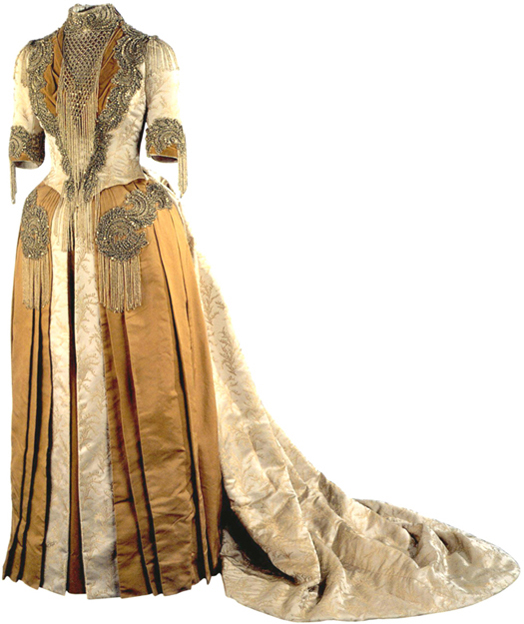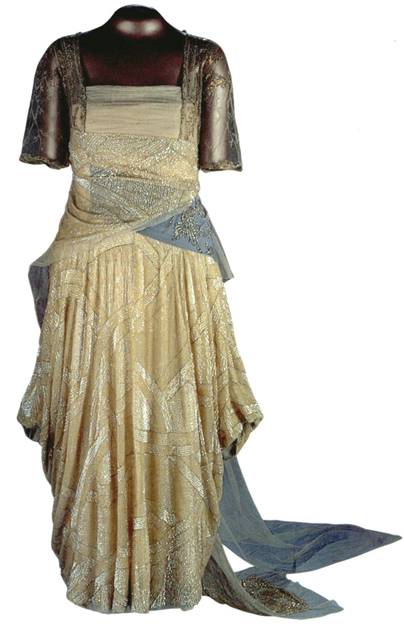
“There was opened to the public on February 1, 1914, a collection of feminine import, which is quite unique for this country in its largeness of scope and in part at least for its method of presentation.”34 Thus the Smithsonian Institution announced the debut of what would become one of its most popular and enduring attractions: the First Ladies Collection. Although some relics of Martha Washington had accompanied those of her husband into the National Museum in 1883, it was not until 1912 that the Smithsonian began actively collecting objects associated with the women of the White House. Notably, the people who initiated and engaged in this new collecting effort were not curators; they were not even on the Smithsonian payroll.

Dressing a first lady mannequin, Arts and Industries Building, 1915. Cassie Julian-James (left) and Rose Gouverneur Hoes (right), founders of the Smithsonian’s First Ladies Collection, dress a mannequin in a gown worn by Louisa Catherine Adams, wife of President John Quincy Adams. Part of the National Museum’s historic costume exhibition, the mannequin, trimmed with a pair of white satin slippers, was displayed inside a glass case with another mannequin representing Abigail Adams. (photo credit 14.1)
Cassie Mason Myers Julian-James, a wealthy Washingtonian, had first taken a personal interest in the National Museum in the late 1890s, when she began depositing family mementos in the collections.
As a member of the social elite, Julian-James shared with many of her peers a belief that the role of the upper classes was to uplift the public by educating them about good taste and good citizenship. Museums of art and history, which proliferated in the United States during the last quarter of the nineteenth century thanks to the generosity of Gilded Age millionaires, provided ideal opportunities for such cultural and civic instruction. By presenting American history through the biographies of virtuous and patriotic individuals, the Smithsonian and other museums aimed to inculcate those same traits in visitors. But as a woman, Julian-James was concerned that, among the historical figures honored at the National Museum, there were no women role models to be found.

Mary Harrison McKee’s gown, 1889. McKee, the daughter of President Benjamin Harrison, wore this silk brocade gown at her father’s inauguration in 1889. A political as well as a fashion statement, the dress-designed and made in the United States—reflected President Harrison’s support for American industry. McKee loaned her gown to the Smithsonian in 1915 for the new first ladies exhibition. Thirty years later her children converted the loan to a gift, allowing the dress to remain a permanent part of the collection. (photo credit 14.2)
Intending to remedy this, in 1912 Julian-James proposed that the Smithsonian establish a collection of American historical costumes to illustrate changes in women’s fashion from the colonial era to the present day. Taking charge as the de facto costume curator (the all-male Division of History staff was no doubt only too happy to step aside), she set about mobilizing friends and acquaintances to clean out their attics and find old family clothing for the museum. One of the women asked to contribute was Rose Gouverneur Hoes, the great-granddaughter of President James Monroe. Together, Hoes and Julian-James came up with the idea for a special display of a particular category of historical costumes: dresses worn by first ladies. They collected their first gown from Helen Taft, the incumbent first lady, and by 1914, when the exhibition opened, the two women had acquired the costumes of thirteen other White House hostesses.
The Period Costume Collection was an instant success. Visitors marveled at the beautiful dresses, especially those of the first ladies, which were modeled by ivory-tinted plaster mannequins in classical poses. The mannequins’ faces were the same, not individual portraits, but they had distinctive period hairstyles, and many were displayed with antique furniture and other accessories. Surveying her handiwork, Julian-James pronounced it “a most valuable collection of historic costumes of the great women of our country of whom we are so justly proud.”35
With the installation of the First Ladies Collection, the Smithsonian for the first time accorded famous women a place of honor. The exclusion of women before 1912 reflected a traditional conceit that fame was a public enterprise, achieved by great deeds in war and politics: and industry, arenas reserved for men alone. A woman’s place was at home, tending the hearth and providing emotional and spiritual sustenance for her family. The belief that men and women belonged to separate spheres, public and private, pervaded nineteenth-century American society and supported the view that only great men—not women—made history.

Martha Washington’s gown, 1780s. Made of salmon pink faille, Mrs. Washington’s dress features a hand-painted pattern of flowers and insects. It was first displayed in the original First Ladies Hall, which opened in the Arts and Industries Building in 1914. On loan for many years, the dress became part of the permanent collections in 1929 and remains on view today in the current first ladies exhibition. (photo credit 14.3)

Florence Kling Harding’s gown and wrap, 1920s. Evoking the flapper era, this iridescent dress, made of tulle adorned with pearlized sequins and gold beads, was worn by Mrs. Harding during her husband’s administration (1921–23). Long in the possession of Mrs. Harding’s granddaughter, the costume was donated to the Smithsonian in 1966. (photo credit 14.4)

Eleanor Roosevelt’s inaugural dress, 1933. When Mrs. Roosevelt wore this lavender velvet day dress at her husband’s first inauguration on March 4, 1933, the press dubbed the color “Eleanor blue.” In 1945 she donated the dress to the Smithsonian along with the gown she wore to her husband’s fourth inauguration. (photo credit 14.5)

Hillary Rodham Clinton’s inaugural gown, 1993. This gown, a blue-violet beaded lace sheath with a mousseline overskirt, was created by the New York designer Sarah Phillips and made by Barbara Matera Ltd. Mrs. Clinton formally donated the gown and matching velvet coat, which she wore to eleven inaugural balls on January 20, 1993, to the National Museum of American History in 1995. (photo credit 14.6)
But by the turn of the twentieth century many American women had begun to stake a claim on the public sphere. They saw their domestic responsibilities as a justification for political action and initiated reform efforts to improve family life for all Americans, not just their own. More women attended college and entered the workforce. As they sought economic independence and social reform, they also sought political equality and demanded the right to vote.
It was therefore fitting that at just this moment the first ladies entered the National Museum. Historically, first ladies have occupied a unique position in society, somewhere between the private and public spheres that conventionally defined the worlds of men and women. As a wife and mother, the first lady was expected to conform to conventional ideals of womanhood, which were linked to notions of piety, purity, and domesticity. Yet as the wife of the president, she was not restricted to the private sphere of hearth and home but lived—and was expected to flourish—in the public eye. Her house was not a safe haven, insulated from the outside world, but rather an official residence where political affairs intruded on and even dictated domestic activities. Hers was a symbolic and highly visible role: mistress of the nation’s home, mother to the American family.

Lalique “peace” pin presented to Edith Wilson in 1919. The work of the French jewelry and glass designer René Lalique, this pin was a gift to Mrs. Woodrow Wilson when she accompanied the president to the Paris Peace Conference following World War I. Mrs. Wilson donated the pin to the Smithsonian in 1953. (photo credit 14.7)
In many ways the First Ladies Collection was a conservative response to the changing role of American women in the early twentieth century. In keeping with traditional gender roles and the uplifting agenda of the cultural elite, the Smithsonian commemorated first ladies as guardians of social graces, fashion sense, and moral virtue rather than for their intellectual or political activities. Yet, significantly, the collection also defined, promoted, and celebrated women as public figures. As women struggled to claim a place on the political stage, the First Ladies Collection claimed a place for them on the historical stage—a place that, however narrowly defined, in turn paved the way for women in the Smithsonian.

Patricia Nixon party favor, 1960. Many presidents’ wives have participated in their husbands’ political campaigns. In 1960 Patricia Nixon hosted women’s teas and luncheons to enlist support for her husband, Richard Nixon, the Republican presidential candidate. This party favor is part of the Ralph E. Becker Collection of Political Americana, donated to the Smithsonian in 1961. (photo credit 14.8)
Over the years the First Ladies Collection has itself evolved in response to changing interpretations of women’s place in history and the first lady’s role. During Women’s History Month in 1992, eighty years after Julian-James and Hoes collected their first White House gown, a new exhibition opened at the National Museum of American History. Entitled First Ladies: Political Role and Public Image, the exhibition looked beyond the gowns and period rooms to better understand the lives and experiences of the women themselves.36 While the ever-popular gowns are still there, the exhibition also features many more artifacts from the First Ladies Collection that together offer clues to their complex and multifaceted roles. Visitors see first ladies not only as fashion plates and hostesses but also as political campaigners, social activists, and diplomats. As women who simultaneously lived both public and private lives, first ladies embody the contradictions and conflicts that accompanied the changing role of women in American society. In a unique way their stories reflect debates over what it has meant to be an American woman.

State china from the Lyndon B. Johnson administration, 1968. For her White House china pattern, designed by Tiffany and Company, Lady Bird Johnson chose American flowers, reflecting her interests in the environment. This dessert plate features an American Beauty rose, the official flower of the District of Columbia. Through her “Beautify America” campaign, the first lady urged citizens to clean up and improve their neighborhoods and planted flowers along the nation’s highways and in public areas in the capital city. When Mrs. Johnson commissioned this china, she also had a special set produced for the Smithsonian’s White House china collection. (photo credit 14.9)